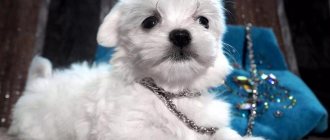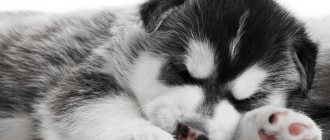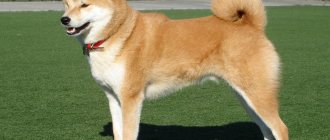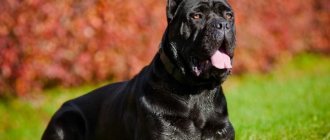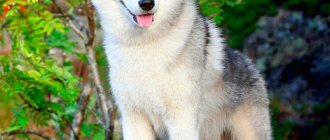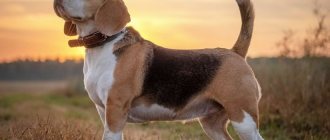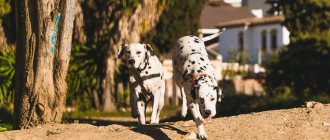Known for its unrivaled hunting skills, the German Spaniel, also called the German Wachtelhund or German Quail Dog in its native Germany, has historically been used as an all-around hunting dog. The dog boasts great strength and endurance. Since the animal has a significant prey drive, having a pet as an ordinary pet would not be the best idea for most owners.
These dogs adapt very well to new conditions, quickly get used to people, and get along well with strangers. In the presence of small children they can behave noisily, lively, and playfully. They are somewhat stubborn by nature, but at the same time extremely loyal, intelligent, and easy to train. These qualities play a big role in hunting, making their owners masters of tracking and hunting. Additionally, the German Spaniel is gaining popularity as a loyal companion dog.
Let's get to know the German Spaniel better, because this wonderful breed is definitely worthy of our close attention.
Appearance and characteristics of the breed
The German Wachtelhund is a strongly built, medium-sized spaniel with long, wavy hair. The hair is quite coarse, especially long on the back of the legs and tail. The fur curls most around the ears, the back of the head and at the base of the tail.
The German Spaniel has a long back in relation to its height and a fairly strong skeletal system. The spaniel has a beautiful noble posture, the head and muzzle have a graceful elongated shape.
The nose is dark, the lips are tightly compressed, and have pigmentation. The eyes are slightly slanted, with close-fitting eyelids, which are also pigmented in accordance with the coat color. The color of the iris is dark brown. The ears, like those of all spaniels, are long, drooping, with a lush fringe of curly hair.
The physique is fit, athletic, the neck and back are strong and muscular. The latter is connected to a slightly downward sloping croup, which in turn ends in an extremely expressive tail. The chest is very wide, moderately deep, the stomach is tucked, but not too much. The forelimbs have strong muscles, and the hind limbs have strong, wide and heavy bones.
In the photo below you can see all the nuances of the description of this breed.
The Wachtelhund is used for hunting and tracking prey in difficult conditions, for example, on ice, in the mountains, in water, in snow. The German Spaniel has an excellent sense of smell and an innate tendency to search for game and bring it to its owner.
The Wachtelhund performs best in searching for game by following the blood trail in the thicket of the forest, and also perfectly tracks prey by feathers or fur. Moreover, with proper training, “Germans” can work independently.
Brief characteristics:
- Height: 45-54 cm.
- Weight: 18-25 kg.
- How long they live: 12-14 years.
- Color: fawn, white, brown, gray, red, liver.
- Temperament: smart, lively, friendly, versatile, brave, sociable.
Description
Translated from German, the name Wachtelhund means quail dog. Although representatives of the breed scare away feathered and land game and bring in wounded animals, the spaniel works with particular passion for quail. The appearance of the animal fully corresponds to the specialization of the breed: a compact body in the shape of a rectangle, strong paws, a small movable tail - an excellent balancer. The German Spaniel breed standard prescribes a male weight of 25-28 kg with a height at the withers of 50-52 cm. The dimensions of the female are more modest: weight 18-20 kg, height 45-48 cm.
The head of the representative of the German Wachtelhund breed is elongated, with a sloping large forehead. The ears are medium length, hanging, set high. The legs are low in relation to the body. The body shape is a lying rectangle. When working in fields and forests, a dog with such a body and legs can easily maintain balance in pursuit of a fast-moving hare or fox. The animal's coat is medium length, silky, without thick undercoat. Once wet in water, it dries quickly. The color is brown and red with a red tint. White spots are allowed on the face, toes, and belly.
Character
The Wachtelhund has a friendly character and is completely devoid of aggression towards humans. The dog is smart, devoted to its owner, and ardent in its work.
Representatives of the breed are successfully used for hunting and sports. Passion, perseverance and tenacity in tracking down game are the main characteristics of the German Wachtelhund. An innate sensitive sense of smell and good “voice work” allow you to hunt with a dog in the forest, in swamps, and in the snow in winter. The spaniel without hesitation goes into the water and brings back the shot bird.
Training
Raising a dog begins from the first hours of the puppy's appearance in the house. The child is set the limits of acceptable behavior in the family. The German Spaniel has a lively mind and is able to easily learn new commands. However, he has a strong character and will only listen to one person with a strong leadership character.
History of the origin of the breed
The breeding of the German Quail Dog began in the 19th century in Germany. The need to breed the Wachtelhund was explained by the need for a universal breed that would combine the abilities of a bloodhound, a pointer, and could track, drive and extract different types of prey in any, even the most difficult weather conditions and on different types of terrain, be it a dry area or a swampy area .
To obtain the desired station wagon, breeders set out to recreate the Steber (an ancient spaniel-like breed known in Germany since 1719). The Old German bloodhound had many hunting talents and demonstrated excellent results (no worse than the bloodhound, known for its unsurpassed hunting skills).
The Stebers generally belonged to the ruling classes, which had a monopoly on hunting in Germany in the 19th century. However, after the peasant uprisings of 1848, the common man was also given the right to hunt. For this purpose, a universal hunting dog was needed that could replace a pack of different specialized breeds. .
To find a representative of the ancient breed, the breeder had to travel all over Germany. As a result, they managed to find several purebred Stebers in Bavaria. Breeders then crossed this Steber breed with different types of spaniels, which also had excellent hunting abilities. It is believed that one of them was a springer spaniel, but there is no information about the others at all.
The result was the desired Wachtelhund, which in German means “quail hunting dog.” The official breed standard was approved in 1981 and at the same time it was given its current name - German spaniel.
In Germany, a license is required to own such a dog. This permit can be obtained by hunters and gamekeepers.
Spitz: German, Pomeranian, Eurasier
Among the Spitz who come from Germany, the German, Pomeranian and Eurasier Spitz are of greatest interest to professional breeders and ordinary lovers of these animals. To make it easier to navigate these varieties, the table provides general information about the characteristics of each of the representatives of the listed dog breeds:
German Spitz
| Spitz type | Character | Features of wool | Color | Weight, kg | Height, cm | ||
| Male | Female | Male | Female | ||||
| German | Balanced, loyal, smart, affectionate, diligent. | Lush, thick, coarse with a delicate undercoat | Black with black undercoat, brown, zone grey, white, orange, cream, cream-sable, black and tan, multi-colored. | Suitable for height | 18–35,5 | ||
| Pomeranian | Playful, loyal, brave, active, smart. | Soft, long | Black, black and tan, brown, sable, orange, cream, blue, bluish and tan, white, two-tone. | 2–4,5 | 18–22 | ||
| Eurasier | Balanced, energetic, intelligent, loyal, not aggressive, cautious with strangers. | Medium length hair with dense undercoat | Black, black and tan, red, red, zone grey, gray and tan. | 23–32 | 18–26 | 52–60 | 48–56 |
Dogs of the Eurasier breed
Diseases and health problems
When breeding the breed, the breeders did their best. They made every effort to rid the German spaniel of serious hereditary pathologies.
However, like all purebred dogs, the Wachtelhund is predisposed to some specific abnormalities that every potential owner should be aware of. Most often, pathologies of the extremities are observed, which lead to decreased mobility and premature development of arthritis.
Among the diseases characteristic of “Germans” are the following:
- Elbow dysplasia. It appears in puppies at the moment when their weight becomes large enough to cause deformation of the joint. The disease can be prevented using x-ray screening.
- Epilepsy. Manifests itself in episodic seizures of varying intensity. If not treated with medication, the pathology will remain for life, only getting worse over time.
- Hip dysplasia. Causes joint pain and lameness. Affects the hind limbs. Signs appear by 7 months and may include stiffness after lying down or reluctance to jump. Like elbow dysplasia, it can be detected during an X-ray examination.
- Patella dislocation. When the hindquarters are in a flexed position, the kneecap may move out of its normal position. As a result, the dog will feel discomfort and exhibit an awkward three-legged gait. In most cases, the kneecap returns to its original position. But if this happens constantly, then arthritic changes will occur in the knee joint. Corrective surgery can help avoid such consequences.
- Sebaceous cysts. The oily skin of the German Spaniel is prone to the formation of sebaceous lumps. Although cysts are relatively harmless, they can become damaged, causing inflammation and requiring their removal.
Elbow and hip dysplasia can be prevented through proper education. This condition can be easily treated with a healthy diet rich in healthy oils. In this case, the individual in which the problem has been identified is excluded from further breeding.
Other diseases characteristic of the Wachtelhund include:
- obesity;
- skin allergies;
- oncology.
Choosing a German Wachtelhund puppy
The German Wachtelhund is very popular in Germany and many other European countries. In Russia, the total population is about 50 dogs. There is a breed club registered in the RKF - “Vakhtelklub”. It brings together lovers and breeders, plans matings, registers litters, and helps in finding and selling puppies. In Ukraine, the population is about 10 dogs, mostly imported from Poland.
You should only buy a German Spaniel puppy from trusted breeders or kennels. The parents of the litter must have the correct exterior, character and working qualities, not only according to the owner. The proof is grades from exhibitions and diplomas from operational tests. Tests for common genetic diseases in the breed are encouraged: screening for dysplasia, ophthalmological evaluation. Each puppy must have a brand and a puppy card, a veterinary passport with deworming and vaccination marks. The baby is usually picked up at the age of 8-9 weeks. Outwardly, he should be healthy, active and curious, without signs of cowardice or aggression.
Price
Breeders who are members of the Vakhtelklub adhere to a policy of adequate prices, which vary in the range of 20,000-30,000 rubles. At the same time, a serious selection of potential owners is underway. Prices for puppies that are registered in other societies or without registration are not controlled and no one is responsible for the quality of the litter.
Character and habits of the German spaniel
As for the character and behavioral characteristics of the German quail dog, the breed is extremely energetic, alert and active. He is friendly towards everyone, treats children well, and is not hostile towards strangers and other pets. However, it is important to understand that the German Spaniel, being an avid hunter, will view small animals as prey. The dog demonstrates obedience, fearlessness, and strong affection for its owner.
The pet cannot be locked up for a long time. If there is insufficient physical activity, the dog will get bored and, most likely, will begin to destroy the surrounding space (digging, gnawing, chewing anything that is not lying well).
Representatives of the breed adapt well to new conditions, exhibit high intellectual abilities, learn quickly and are always ready to work. It is this unbridled zeal for hunting that makes the German Spaniel difficult to keep as a regular companion dog.
Character
The Wachtelhund's temperament is very energetic, but at the same time balanced. He will not miss the opportunity to chase the neighbor's cats, but one single call from his owner will be enough to stop such a chase. In general, he is characterized by the following behavioral features:
- These dogs have a natural need to stalk prey, so keeping them in the city as a regular house companion is strictly not recommended. Without hunting and fresh air, this pet will simply wither away and become depressed.
If you have a country house and are a good hunter, then you simply will not find a replacement for this breed. These tailed friends of man can hunt in almost any conditions; they do not hesitate to go into the water or rush through snowdrifts in cold weather.
To read: Japanese Spitz dog maintenance and care, reviews from owners
- Training also goes well, they quickly remember commands and happily carry them out. This process will be especially successful if you give your pet some kind of treat for each completed order.
- In terms of care, they do not require anything unusual for themselves: they eat almost everything, have good health and happily take baths.
Breed standard
The officially established breed standard according to the FCI system includes the following characteristics:
- General form . Medium size, well-developed muscles, long hair, noble posture, strong bones. The dog is rather long than tall.
- Head . The skull is flat and moderately wide. The transition from the forehead to the muzzle is weakly expressed. The nose is large and dark. The bridge of the nose is wide, the muzzle is not pointed. Lips are thin, dry, and pigmented. bite . A pincer bite is also allowed. The teeth are large and well developed. The cheekbones are flat and do not jut out. The eyes are brown or darker, medium in size, slightly slanted. Sunken or bulging ones are not allowed. The eyelids fit tightly and are covered with hair. The ears are set high, do not curl or protrude. Evenly covered with hair. When pulled forward, the ear should reach the nose.
- Neck . Powerful, muscular, without dewlap in the lower part. Forms an obtuse angle with the withers.
- Frame . The topline is straight, and the croup area is somewhat sloping. The tail smoothly continues the line of the top.
- Withers . Vividly expressed. The back is strong, short, and does not sag.
- Lower back . Wide, with very developed muscles.
- Croup _ Slightly tapered, but not narrowed. Located just below the line of the withers.
- Rib cage . Oval in front, reaches the elbows from the side. Quite convex, not barrel-shaped, long.
- Belly . Quite fit, covered with thick hair.
- Tail . To prevent the dog from injuring it during the hunt, the tail is docked by a third (or less) during the first 3 days after birth. In some countries, tail docking is prohibited.
- Limbs. The front ones are straight, parallel. The shoulders are muscular, the shoulder blades are laid back. Elbows pressed to the body. The front and hind feet are thick, elastic, pigmented, with strong claws. Hind legs: straight, parallel. The hips are wide and muscular. The knees are strong.
- Movements . Free, sweeping.
- Leather _ Fits tightly and has no creases or pigmentation.
- Wool. Long, thick, close to the body, curly (rarely curly) or smooth. Has a dense undercoat. There is a dewlap on the tail, and feathering on the back of the limbs. Sometimes there is a "jabot". The ears are covered with curly hair. The hair on the head and muzzle is short and thick. Between the toes there is thick, but not very long, hair. Colour : Solid brown, sometimes red, including various shades of red, often with white markings on chest and legs. The second type involves brown-piebald or red-piebald options, where the main color is tightly mixed with white hair. This also includes piebald color with a white background and large splashes of brown or red. Here you can also find the brindle color, where the white background is interspersed with islands of brown or red hair. Both the first and second types are characterized by tan, that is, red markings above the eyes, on the muzzle, on the limbs and under the tail (but their presence is not necessary).
Any deviation from the above characteristics is a defect or a defect, depending on the degree of severity.
Minor deviations include:
- fleshy lips, presence of jowls;
- damp eyelids;
- sharp transition from forehead to muzzle;
- barrel chest;
- light frame;
- high limbs;
- depigmented lobe;
- fine, sparse or silky coat;
- minor deviations in height and weight.
Serious shortcomings (defects) are:
- dermatitis, eczema and other skin pathologies;
- incomplete set of teeth.
Disqualifying Faults:
- aggressive behavior, fear of game or gunfire;
- malocclusion;
- entropy, ectropy.
Description
The German Wachtelhund, also known as the German Spaniel, is a hunting dog breed native to Germany. The dog is not very popular outside its homeland, but they can be found in European countries and America.
German Wachtelhunds make wonderful companions, but only for the owner of the hunter, because this dog cannot live without hunting.
Interesting fact
In German, “Wachtelhund” translates to “quail dog.”
Peculiarities
The German Wachtelhund has a history of more than a century, but the breed was officially recognized a quarter of a century ago. Representatives of this breed are known as courageous hunters who work equally well with large game and birds.
Before using these dogs as hunters, the pet must pass an “exam”, during which skills are tested, namely, the ability to follow the scent, demonstrate the absence of fear of water and the sound of gunshots.
The average height for girls is 45-52 cm, for males 48-54 cm.
The average weight of girls is 18-23 kg, males 20-25 kg.
Interesting fact
The German Spaniel copes equally well with tasks in the forest, on water and in open areas, regardless of the weather.
Distinctive features
Head
The size of the head corresponds to the dimensions of the body. The skull is flattened. The stop is not expressed. The muzzle is short, slightly tapering towards the tip.
Teeth
The teeth are large. Scissor bite, pincer bite is allowed.
Ears
The ears are located at eye level and are quite long. If the ear is pulled back, it should reach the tip of the nose.
Eyes
The eyes are quite small, slightly slanted. Calm and poise can be seen in the eyes.
Frame
The chest is convex, the ribs are slightly curved. The stomach is moderately tucked. The back is straight and strong.
Limbs
The front legs are straight and set parallel. The hind legs are strong, the thighs are muscular.
Wool
The coat fits tightly to the skin and is thick. There is undercoat. Acceptable color is reddish or brown with white markings on the chest. Black German Wachtelhunds are not purebred, although this color is quite common.
Character
German spaniels are calm, they trust their owner and with the proper approach there will be no problems with training. German spaniels are not prone to bouts of aggression. They will bark when they see a stranger, but in most cases the barking is a kind of greeting.
The dogs are very friendly and playful, they truly love their owner, regardless of age. It is worth noting that German Spaniel dogs have the strength and courage to catch large animals.
Quail dogs love to spend time playing with children of any age. The Wachtelhund gets along with other dogs and does not show aggression. Dogs of this breed perceive small animals as prey and can hunt them.
Interesting fact
If the owner behaved rudely or yelled at the dog for no reason, the dog may become offended and refuse to hunt with the owner.
Popularity of the breed. Popular colors
The breed is very popular among professional hunters, but outside German hunting circles the quail dog is not particularly well known. And yet, over time, the Wachtelhund is slowly but surely gaining popularity throughout the world.
At the turn of the 60-70s of the 20th century, the German spaniel was brought to the USA, but in those parts the breed was not able to gain much fame. Now there are about 100 representatives of the breed in the USA and Canada. In 1992, the American Kennel Club officially recognized the German Quail Dog, and 4 years later the breed was registered with the United Kennel Club.
In other countries, such as Canada, the Wachtelhund is used to hunt black bear, which is a testament to the dogs' innate bravery. In Sweden, German spaniels participate in wild boar hunting, which also requires showing strength, endurance and fearlessness.
As for colors, the German Spaniel is traditionally presented in two colors:
- solid dark brown, sometimes red (including red variants - fox, deer);
- brown roan, sometimes red roan, roan with large brown or red markings on a white background, brindle (red or brown spots scattered on a white background).
How to choose a puppy
Hybrid breeds are low-fertility - there are no more than four puppies in a litter, and it is not a fact that each of them will have a full set of basic breed qualities. Therefore, puppies of exotic Russian Wolhunds are very expensive - the price of hybrids of the first and second generations starts from one hundred thousand rubles.
In childhood they at least slightly resemble malamutes, but this will soon pass
Today it is possible to purchase such a baby with confirmation of its breed only in Yulia Ivanovich’s nursery. Of course, in principle, anyone can follow the path of this breeder - to do this, you just need to find a male black Canadian wolf and mate him with a Malamute bitch: what happens is what happens... However, there are enterprising breeders who minimize for themselves difficulties and simply pass off large mongrel puppies that are somewhat similar to it as a rare breed - such dubious offers also come across on the Internet.
What you need to pay attention to when choosing an exotic baby Russian Wolfhund:
- on the head - its shape resembles a regular blunt wedge;
- in the eyes - they are not brown, like all dogs, but yellow, like a wolf's; in a very small puppy, the color of the iris should be sky blue, not gray;
- on the coat - it should be straight, without waves or creases, and very thick, “stuffed” due to the abundant undercoat;
- on gait - the limbs are very strong, slightly closer together, movements demonstrate a characteristic wolf gait (smooth and leisurely jogging: a sweeping trot or gallop).
Wolfhund puppies grow fast but mature slowly
Care and maintenance
The German Wachtelhund should exercise more than it rests, especially on days when it is not hunting. During such periods, vigorous activity should take at least 3-4 hours.
Despite the long, thick coat that sheds twice a year (in spring and autumn), the German Spaniel does not require special care. It is enough to brush his teeth 2 times a week and wash as needed without using shampoo.
The Spaniel's long ears need to be regularly checked: they must be kept clean and dry, otherwise an ear infection may develop.
The Wachtelhund's nails grow quickly, so they need to be trimmed regularly. The procedure will help avoid delamination and cracking. It is also recommended to trim long hair on the limbs and around the crotch to help keep the dog clean.
Nutritional features - what is best to feed?
Like all hunting dogs, the German Wachtelhund needs nutritious, complete food rich in protein.
With natural feeding, approximately 2/3 of the diet should be lean muscle meat and offal, with the exception of bones, kidneys and raw liver.
To them you should add a little porridge made from oatmeal, rice or buckwheat, as well as boiled or raw vegetables. Fermented milk products - cottage cheese, kefir and natural low-fat yogurt - are useful, especially for growing puppies.
Once a week, it is recommended to replace meat with boiled sea fish without bones, and you should give fish one and a half times more than meat.
The German Spaniel is also suitable for feeding with a premium quality complete food or higher.
At the same time, it is very important to choose the right brand in accordance with the size, age and physical condition of the pet.
For a dog suffering from a disease that requires food restrictions, special dietary foods are best suited.
Education and training
The German spaniel easily adapts to the life of a hunter and quickly masters the necessary commands, because tracking and catching prey is a natural activity for him.
Even when running long distances from his owner, he is always ready to return without the slightest protest.
Socialization is not a problem for this friendly and sociable breed. However, take into account her stubborn nature, which is especially evident in the process of learning commands not related to hunting.
Training should begin as early as possible. Basic commands such as “sit” and “near” can easily become ingrained in everyday life during feeding or walking.
Training should be done with positive reinforcement. Harsh methods are excluded. The main methods of teaching: encouraging correct behavior and ignoring bad behavior (or distracting attention). With a German spaniel, these techniques will be most effective, since the dog is highly motivated by tasty food and, moreover, always strives to please its owner.
Training a German Wachtelhund
Thanks to their flexible mind and high intelligence, spaniels are highly trainable, quickly learning new tricks and skills. However, for a “German” to begin to carry out someone’s commands, this person must become an indisputable authority for the dog. Calmness, confidence and timely encouragement of your pet's success with treats and affection will help you achieve obedience from your dog.
You can punish a dog, but only deservedly. “German quails” are distinguished by a keen sense of justice. Unmotivated punishments cause dogs to withdraw into themselves and undermine their trust in their owner, which slows down the training process and negatively affects the animal’s psyche.
How long do dogs live?
The lifespan of a Toy Poodle depends on care and nutrition throughout its life, and can range from 15 to 25 years. With a proper diet and frequent walks, the risk of disease becomes less, and the pet’s chance for longevity is higher. Of course, life expectancy is affected by the presence of all vaccinations.
Closely monitor your pet's physical and emotional health.
You need to comb your pet every day, given its high hairstyle, this is very important. Use a massage brush to brush, and after the procedure, wipe the coat with a damp, warm towel to relax the pores. To prevent an unpleasant dog odor at home, the toy poodle needs to be bathed more often than other breeds - from 6 to 8 times a month
Be sure to use a special shampoo with a complex of vitamins and herbs. As stated above, they are susceptible to baldness; to ensure strong hair follicles, procedures must be done to strengthen them. After a walk, be sure to wash your pet’s paws and belly to prevent bacteria from appearing, bathe as necessary, but if he bathed in dust, then be sure to give him a bath. Temper your dog from a young age. To do this, you need to walk the puppy in any weather and play with him. But monitor your pet’s body temperature; do not overcool or overheat your pet. This can negatively affect your pet's blood vessels. You cannot let your dog swim in rivers or ponds on his own until he is 4 months old, because his legs and joints have not yet fully formed, he may simply not be able to stay on the water.
- A pet's haircut should be done at least once a month, and if it's summer, it's better to do it more often so that the pet doesn't overheat.
- Nail trimming, like haircutting, should be done at least once a month (depending on circumstances). The procedure must be performed with special tools: a plier-shaped nail cutter is more reliable than a scissor-like one.
- Accustom your dog to walking from the very moment the pet arrives in the family. It is necessary to walk with him every 2-3 hours so that he understands that he needs to relieve himself only on the street. This is also necessary for proper metabolism, so as not to cause obesity in the dog.
- A mandatory event should be a visit to the veterinarian once every six months, checking the teeth for the presence of stones, and checking the coat for growth pattern. Until you have completed all the vaccinations, it is not advisable to take your dog outside. To preserve the health of the pet, the puppy can be taken outside after the full quarantine period. And at this time, train the puppy to use the tray. It is worth remembering that the tray will also be useful in rainy weather. Under no circumstances should you take your dog outside in rainy weather, then the risk of contracting the disease is many times higher.
This breed suffers from more pain than any other dog. This is due to historical factors, since dogs of this breed have always been “kissed”, neglected, pampered, so their immunity is not adapted to hunting (as inherent in nature). Diseases of the joints, teeth, diabetes mellitus and high glycemic index are very common.
Problems with the respiratory tract (disease of the trachea, such as collapse leading to the death of the pet), increased risk of such a dangerous disease as epilepsy. And in old age, dogs are plagued by problems such as tooth and hair loss, blindness (cataracts) and deafness. Some dogs are born with hearing problems.
If you monitor your pet’s health throughout its life, spend a sufficient amount of time outside, get all vaccinations, and organize proper nutrition, then you don’t have to worry about the state of your dog’s body in old age. The living conditions of a poodle in an apartment will directly affect the emotional state of the puppy and its well-being and self-confidence. And also on life expectancy.
Baby Affenpinscher
This representative of dwarf breeds reaches a height of about 25–30 cm. Weighs on average from 4 to 6 kg. The dog's appearance is characterized by:
- erect, pointed, widely spaced ears;
- high-set tail;
- hard, thick, straight coat;
- soft, wavy undercoat;
- bushy eyebrows, mustache and beard;
- dark, black with gray or red tan, brown, bluish, red, gray colors.
Affenpinscher
The dog has a playful, courageous, curious and friendly disposition. She is very loyal to her owner. Wary of strangers. Endowed with guard qualities. Can't stand loneliness. Barks often. The photo shows an image of a typical representative of this breed.


